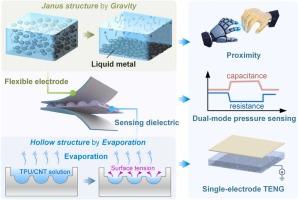Evaporation meets gravity: Natural-force-driven fabrication of multifunctional flexible sensors for pressure, proximity, and material recognition
IF 17.1
1区 材料科学
Q1 CHEMISTRY, PHYSICAL
引用次数: 0
Abstract
Multifunctional flexible sensors play a pivotal role in applications requiring intelligent tactile, such as soft robotics and prosthetics. However, their development is often hindered by complex fabrication processes and high costs. This study presents a simple, scalable strategy for fabricating a multifunctional flexible sensor by harnessing natural forces—evaporation and gravity. A thermoplastic polyurethane elastomer/carbon nanotube (CNT) sensing dielectric with a hollow dome structure is prepared via natural evaporation. Subsequently, gravity-driven sedimentation of liquid metal (LM) in a polydimethylsiloxane (PDMS)/CNT solution is employed to fabricate a Janus-structured PDMS/CNT/LM film. The components are assembled into a sandwich-type sensor integrating multiple sensing mechanisms: piezoresistive/piezocapacitive effect, fringing effect, and triboelectric nanogenerator (TENG). The sensor exhibits considerable pressure sensitivity (0.044 kPa⁻¹), a fast response time of TENG (< 20 ms), and a non-contact sensing range of approximately 20 cm. Dual-mode capacitive–resistive sensing enables seamless detection of approach, touch, and pressure without crosstalk. Moreover, the synergistic between the TENG and the piezoresistive/capacitive responses allows for dynamic and static pressure perception and enables intelligent material identification with over 93 % accuracy when assisted by a Random Forest algorithm. This work highlights the potential of natural forces in the design and fabrication of flexible sensors.

蒸发满足重力:用于压力,接近和材料识别的多功能柔性传感器的自然力驱动制造
多功能柔性传感器在需要智能触觉的应用中发挥着关键作用,如软机器人和假肢。然而,它们的发展往往受到复杂的制造工艺和高成本的阻碍。这项研究提出了一种简单的、可扩展的策略,通过利用自然力量——蒸发和重力来制造多功能柔性传感器。采用自然蒸发法制备了一种中空圆顶结构的热塑性聚氨酯弹性体/碳纳米管传感电介质。随后,在聚二甲基硅氧烷(PDMS)/碳纳米管溶液中重力驱动液态金属(LM)沉积,制备了双面结构的PDMS/CNT/LM薄膜。这些元件被组装成一个三明治式传感器,集成了多种传感机制:压阻/压电容效应、条纹效应和摩擦电纳米发电机(TENG)。该传感器具有相当高的压力灵敏度(0.044 kPa - 1),快速响应时间为TENG (< 20ms),非接触式感应范围约为20cm。双模容阻传感能够无缝检测接近、触摸和压力,而不会产生串扰。此外,TENG和压阻/电容响应之间的协同作用允许动态和静态压力感知,并在随机森林算法的辅助下实现智能材料识别,准确率超过93%。这项工作突出了自然力量在柔性传感器设计和制造中的潜力。
本文章由计算机程序翻译,如有差异,请以英文原文为准。
求助全文
约1分钟内获得全文
求助全文
来源期刊

Nano Energy
CHEMISTRY, PHYSICAL-NANOSCIENCE & NANOTECHNOLOGY
CiteScore
30.30
自引率
7.40%
发文量
1207
审稿时长
23 days
期刊介绍:
Nano Energy is a multidisciplinary, rapid-publication forum of original peer-reviewed contributions on the science and engineering of nanomaterials and nanodevices used in all forms of energy harvesting, conversion, storage, utilization and policy. Through its mixture of articles, reviews, communications, research news, and information on key developments, Nano Energy provides a comprehensive coverage of this exciting and dynamic field which joins nanoscience and nanotechnology with energy science. The journal is relevant to all those who are interested in nanomaterials solutions to the energy problem.
Nano Energy publishes original experimental and theoretical research on all aspects of energy-related research which utilizes nanomaterials and nanotechnology. Manuscripts of four types are considered: review articles which inform readers of the latest research and advances in energy science; rapid communications which feature exciting research breakthroughs in the field; full-length articles which report comprehensive research developments; and news and opinions which comment on topical issues or express views on the developments in related fields.
 求助内容:
求助内容: 应助结果提醒方式:
应助结果提醒方式:


